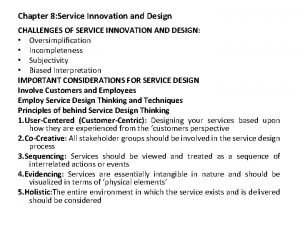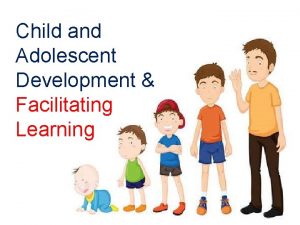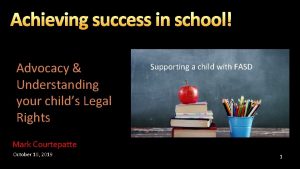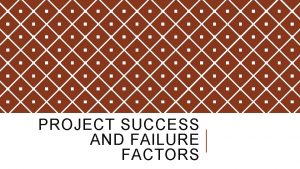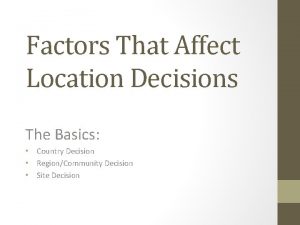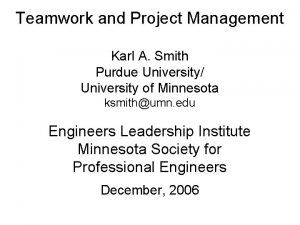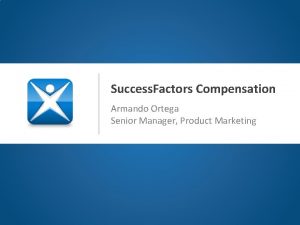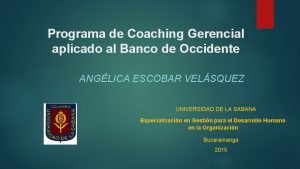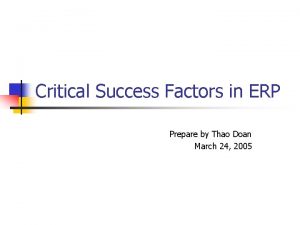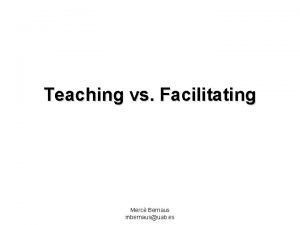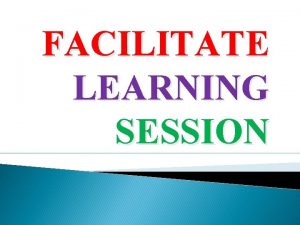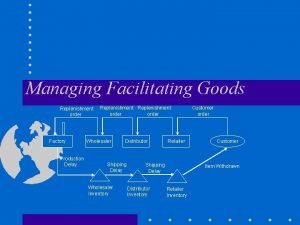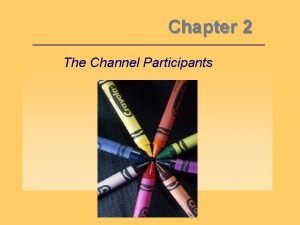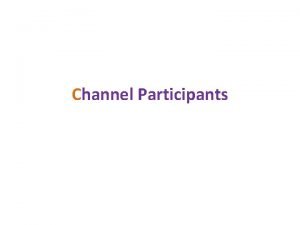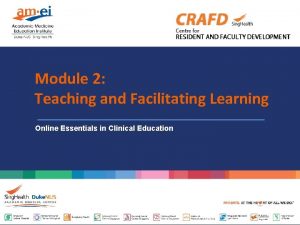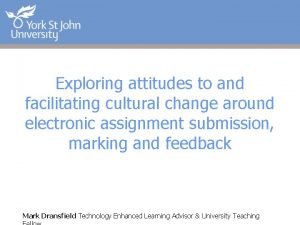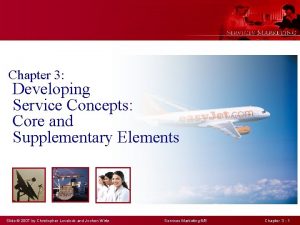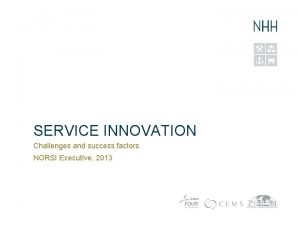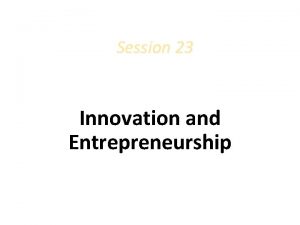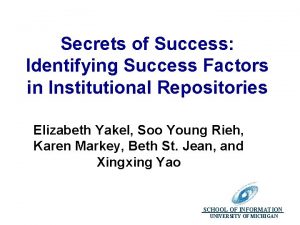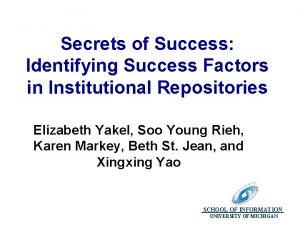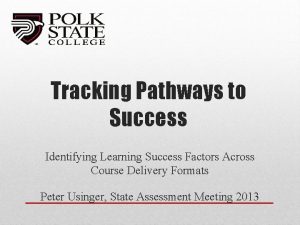THE SUCCESS FACTORS AND CHALLENGES OF FACILITATING INNOVATION





















































- Slides: 53

THE SUCCESS FACTORS AND CHALLENGES OF FACILITATING INNOVATION THE CASE OF INTERNATIONALISATION@HOME Melissa De Wilde, Project researcher (Educational innovation) 1

CONTENT 1. Introduction 2. The ‘birth’ of the project 3. Creating a framework 4. Getting started… 5. Time for action! 6. Lessons learned so far 2

1. INTRODUCTION 3

1. INTRODUCTION – GHENT UNIVERSITY • Ghent University (Belgium, Flanders) Ø Over 42, 000 students Ø Campusses both local (Ghent, Bruges, Ostend, Kortrijk) and global (South Korea) Ø 11 faculties, 200 offered courses in both exact and social sciences Ø Ranking o Shanghai Ranking 2019 66 o World’s most innovative universities 88 o World University Ranking 2019 123 4

1. INTRODUCTION – GHENT UNIVERSITY? • Ghent University (Belgium, Flanders) Ø Our motto? Dare to think! 5

1. INTRODUCTION – OUR FACULTY • Faculty of Psychology and Educational Sciences Ø Around 4700 students Ø 9 Academic departments Ø Bachelor and Master degrees in o Psychology (Clinical, Business, Theoretical/Experimental) o Educational Sciences o Disability Studies o Social Work o Teacher training (educational masters degree) 6

1. INTRODUCTION - INNOVATION • Policy of educational innovation Ø Faculty funding for ‘yearly’ projects in innovative educational practices • Faculty-related projects Ø Within own faculty or with partner – faculties Ø Subjects chosen by Faculty board • Competitive projects Ø Cooperation between at least three faculties Ø Competing for funding from central department Ø Three project get chosen each academic year 7

NUTSHELL • My story in a nutshell… 8

2. THE BIRTH OF THE PROJECT 9

IDEA • Expectations versus reality… on internationalisation • Internationalisation seems ‘high on agenda’ Ø But is it really ? How is it perceived by students and staff members? Ø How accessible is ‘internationalisation’ to all students and staff? 10

IDEA • Finding partners… ØFaculty of Economics and Business Management ØFaculty of Bio-Engineering Sciences • Competitive project ØFunded by central department ! 11

3. CREATING A FRAMEWORK 12

3. CREATING A FRAMEWORK Lifting the ‘conceptual fog’ Ø No clear definition of ‘internationalisation at home’ or ‘intercultural competences’ to facilitate a common vision (Jones & Beelen, 2015) 13

3. CREATING A FRAMEWORK Defining “Intercultural competences” Ø “The ability to develop targeted knowledge, skills and attitudes that lead to visible behavior and communication that are both effective and appropriate in intercultural interactions. ” (Deardorff, 2006) Defining “Internationalisation at home” Ø “The purposeful integration of international and intercultural dimensions into the formal and informal curriculum for all students, within domestic learning environments. ” (Beelen & Jones, 2015) 14

3. CREATING A FRAMEWORK - Further defining 1. I@Home. . . Offers all students a global experience 2. 3. 4. 5. within their programme of study, whether or not they spend time abroad. Moves beyond electives or specialised programmes. Involves developing international and intercultural perspectives through internationalised learning outcomes in the formal curriculum. Is supported by informal (co)curriculum activities across the institution. Makes purposeful use of cultural (Jones & Reiffenrath, 2018) diversity in the classroom for inclusive learning, teaching and assessment practice. 6. Creates opportunities for student engagement with ‘cultural others’ in local society. 7. Involves all staff, not only academics and international officers. 8. May or may not include teaching in English or another lingua franca. 9. Can include virtual mobility through online working with partner universities. 10. Fosters purposeful engagement with international students. 15

3. CREATING A FRAMEWORK ‘Comprehensive internationalisation’ (Hudzik, 2011) “… is a commitment, confirmed through action, to infuse international and comparative perspectives throughout the teaching, research, and service missions of higher education. It shapes institutional ethos and values and touches the entire higher education enterprise. ” => HOLISTIC APPROACH 16

4. GETTING STARTED 17

4. GETTING STARTED PDCA Circle (Deming, 1950’s) 18

4. GETTING STARTED 19

4. GETTING STARTED – ‘PLAN’ ü International culture ‒ Ambition of ‘international institution’ ‒ Rising international student population ‒ International ‘culture’ not felt by students and staff ‒ International office staff members often do not feel ‘heard’ and ‘involved’ 20

4. GETTING STARTED – ‘PLAN’ ü Vision & key concepts ‒ Unclear or different definition of ‘key concepts’ ‒ ‘Conceptual fog’ (Beelen & Jones, 2015) ‒ No ‘clear’ action plan for Internationalization @ Home ‒ Importance recognized, funding present but… 21

4. GETTING STARTED – ‘PLAN’ ü Guidelines and support ‒ Absence of clear guidelines in mission and vision statement ‒ No staff members directly responsible for I@Home ‒ Need for training/support teaching staff in intercultural competency development 22

4. GETTING STARTED – ‘PLAN’ ü Lack of visibility / transparancy ‒ Good practices were already present but Ø No knowledge exchange within / between faculties Ø No available platform for dialogue / sharing Ø No transparency regarding budget 23

4. GETTING STARTED – ‘PLAN’ ü Initiatives often stay in ‘comfort zone’ ‒ More often ‘traditional’ initiatives (guest lectures, field trips abroad, …) ‒ Little exploration of innovative didactics and technologies 24

4. GETTING STARTED – ‘PLAN’ ü Initiatives not ‘for all’ ‒ Mostly ‘facultative’ initiatives (intercultural competency ‘gap’? ) ‒ Little structural integration of international/intercultural dimension curriculum for all students Ø Elective courses, short-term projects, … 25

4. GETTING STARTED – ‘PLAN’ ü Barriers in meaningful intercultural exchange ‒ Between incoming and domestic students Ø Clique’ing, language barrier, prejudice Ø Teachers do not adress this enough ‒ Between foreign and domestic staff members 26

5. TIME FOR ACTION! 27

5. TIME FOR ACTION – ‘DO’ Ø Big ambitions… o Putting I@Home under the ‘management radar’ o More sharing / dialogue / transparency regarding I@Home o Facilitating an ‘international culture’ in the faculty o Pilot projects that experiment with innovative methods and technologies 28

5. TIME FOR ACTION – ‘DO’ Ø Putting I@Home under the ‘management radar’ o A few realisations… • Management support can be quite the illusion • Innovation? Sure! Change? No thank you… • You have to ‘put your foot between the door’ ÞTop down not possible? Then Bottom up it is! 29

5. TIME FOR ACTION – ‘DO’ Ø More sharing / dialogue / transparency regarding I@Home o Across faculties ØFour yearly meetings with international offices across faculties to discuss good practices in I@Home ØIntegrating platform for sharing good practices online ØTeacher support on central level (intercultural 30

4. TIME FOR ACTION – ‘DO’ Ø More sharing / dialogue / transparency regarding I@Home o. Within our own faculty Ø Presence of international office members and faculty board members on each others meetings (opening dialogue) Ø Using Faculty education days (three times a year) to 31

4. TIME FOR ACTION – ‘DO’ Ø Facilitating ‘international culture’ (staff) o International staff taskforce (monthly) Ø Creation of clear welcome guide online for support Ø Faculty contact person for questions Ø Facebook group for support and networking Ø ‘Global lunch moments’ in staff room in Tuesdays and Thursdays Ø More bi-lingual communication in e-mail, invitations, on meetings, … Ø Creating of online platform to connect teachers with international researchers Ø Several informal activities to integrate own and incoming staff (coffee breaks, cultura sharing events, …) 32

4. TIME FOR ACTION – ‘DO’ Ø Facilitating ‘international culture’ (students) o Facilitating interaction between international and own students Ø Structurally supporting the organisation of ‘Buddy project’ • In collaboration with our student society 33

4. TIME FOR ACTION – ‘DO’ Ø Innovative projects within curriculum – looking for opportunities Ø Difficult process • Hard to find and motivate teachers to engage “Is what you’re in pilot trying to do projects! “I want to engage but it’s just too time consuming…” evidence based? I need reassurance that this will work…” 34

4. TIME FOR ACTION – ‘DO’ Ø PILOT: Global interdisciplinary groupwork SDGs Ø Participants • Students from Bio-engineering sciences, Philosophy, Economics and Global Studies (with international students) - BA and MA combined! • Cooperation with students of campus South-Korea (Environmental technology) Ø Duration - 9 weeks 35

4. TIME FOR ACTION – ‘DO’ ØPILOT: Global interdisciplinary groupwork SDGs Ø Main learning goals • Students acquire knowledge of global issues regarding sustainability in a multi-disciplinary learning context (KNOWLEDGE) • Students acquire necessary skills to effectively communicate and cooperate with students from other cultures and/or perspectives (SKILLS) 36

4. TIME FOR ACTION – ‘DO’ ØPILOT: Global interdisciplinary groupwork SDGs Ø Learning tasks for students • Exploring a ‘case’ on sustainability from different disciplines and within an international perspective • Preparing a ‘pro’ or ‘contra’ side of a debate • Showcasing synthesis in an introductory video 37

4. TIME FOR ACTION – ‘DO’ ØPILOT: Global interdisciplinary groupwork SDGs Ø Learning tasks for students • Examples of ‘cases’ ü Zero hunger can only be achieved through GMO’s ü Refusing vaccination should mean losing the right to public health care 38

4. TIME FOR ACTION – ‘DO’ ØPILOT: Global interdisciplinary groupwork SDGs 1. Preparation phase ‒ Important to ‘prepare’ students on this intercultural and interdisciplinary journey Ø Offline sessions to offer students the necessary knowledge and context for the project (session on intercultural communication, 39

4. TIME FOR ACTION – ‘DO’ ØPILOT: Global interdisciplinary groupwork SDGs 2. Exploratory phase (gathering information) ‒ Video introduction from each student (Week 1) ‒ Online exploring of the assigned case from different perspectives (Week 2 – 4) ‒ Original plan: Microsoft Teams (obstacle: IT department…) 40

4. TIME FOR ACTION – ‘DO’ ØPILOT: Global interdisciplinary groupwork SDGs 3. Oxford Style debate preparation ‒ Students deepen their case through the preparation of arguments for the debate ‒ Students create a video message as introduction to their statements 41

4. TIME FOR ACTION – ‘DO’ ØPILOT: Global interdisciplinary groupwork SDGs 4. Symposium (end product) ‒ Showcase stand to show group process ‒ Three parallel debates ‒ Open to all staff and audience 42

4. TIME FOR ACTION – ‘DO’ ØPILOT: Global interdisciplinary groupwork SDGs Coaching and guidance Ø Database of sustainability experts to consult with questions (through connections of teachers, international reseachers) Ø Process guidance by team of teachers and myself 43

4. TIME FOR ACTION – ‘DO’ ØPILOT: Global interdisciplinary groupwork SDGs Assessment Ø Formative assessment: rubrics with criteria per learning task, online feedback Ø Summative assessment: Content quality of arguments in debate 44

4. TIME FOR ACTION – ‘DO’ ØPILOT: Global interdisciplinary groupwork SDGs Acknowledgement Ø All students involved receive credits for project (as part of a course) Ø Project is open to students as ‘extra-curricular’ (more interest than expected!) 45

4. TIME FOR ACTION – ‘DO’ ØPILOT: Global interdisciplinary groupwork SDGs Effect measurement Ø IRC tool (Intercultural Readiness Check) to measure intercultural competence before and after 46

5. Lessons learned 47

48

5. LESSONS LEARNED Challenges ØOverall resistance to change ØHidden agenda’s ØTop management not on the same page (no priority) ØToo time-consuming for teachers (workload) ØSlow process (changing time – line, flexibility) ØIT support lacking ØIt can be a lonely and tiring journey… 49

5. LESSONS LEARNED Success factors Getting your foot in the door hélps Bring in expertise from outside Support is everything – provide it! (pedagogical/technical) Guarantee measurement (cfr. IRC tool) Create opportunities to share experiences and success stories Make yourself hard to ‘miss’ – visibility is everything Go and spread the word as much as you can (create buzz) Go to events to meet like-minded colleagues 50

51

5. LESSONS LEARNED Things to remember when innovating 1. 2. 3. 4. Acknowledge that every small step is relevant Remember: enthousiasm is contagious Pick your battles Learn to let go 52

Ms. Melissa De Wilde Educational Innovation Researcher Faculty of Psychology and Educational Sciences Ghent University Campus Dunant Henri Dunantlaan 2 9000 Gent T +32(0)9 264 94 06 Melissa. Dewilde@ugent. be 53
 Factors influencing of communication
Factors influencing of communication Challenges of service innovation and design
Challenges of service innovation and design Innovation for the sake of innovation
Innovation for the sake of innovation Incremental innovation vs disruptive innovation
Incremental innovation vs disruptive innovation Facilitating learning child and adolescent development
Facilitating learning child and adolescent development Your child's success or lack of success
Your child's success or lack of success Your child's success or lack of success
Your child's success or lack of success Factors of project success and failure
Factors of project success and failure What factors affect region/community location decisions?
What factors affect region/community location decisions? Factors affecting success of multilingualism
Factors affecting success of multilingualism Purdue project management
Purdue project management Fast food industry analysis
Fast food industry analysis Faktor kunci keberhasilan organisasi
Faktor kunci keberhasilan organisasi What makes an attraction successful
What makes an attraction successful Retail success factors
Retail success factors Success factors vail
Success factors vail Key success factors of nestlé
Key success factors of nestlé Success factors banco de occidente
Success factors banco de occidente Success factors
Success factors Teaching vs facilitating
Teaching vs facilitating Facilitate learning session meaning
Facilitate learning session meaning Examples of facilitating goods
Examples of facilitating goods Merchant wholesalers
Merchant wholesalers Classification of channel of distribution
Classification of channel of distribution Importance of marketing channels
Importance of marketing channels Facilitating learning module 2
Facilitating learning module 2 Facilitating cultural change
Facilitating cultural change Core and supplementary services
Core and supplementary services Abiotic factors example
Abiotic factors example Abiotic factors and biotic factors
Abiotic factors and biotic factors Abiotic vs biotic factors
Abiotic vs biotic factors Gcf of 8 and 6
Gcf of 8 and 6 Common factors of 10 and 20
Common factors of 10 and 20 What are the factors of 8
What are the factors of 8 Site vs location
Site vs location Is a car abiotic or biotic
Is a car abiotic or biotic What is site vs situation
What is site vs situation Hình ảnh bộ gõ cơ thể búng tay
Hình ảnh bộ gõ cơ thể búng tay Slidetodoc
Slidetodoc Bổ thể
Bổ thể Tỉ lệ cơ thể trẻ em
Tỉ lệ cơ thể trẻ em Voi kéo gỗ như thế nào
Voi kéo gỗ như thế nào Tư thế worm breton là gì
Tư thế worm breton là gì Chúa yêu trần thế alleluia
Chúa yêu trần thế alleluia Các môn thể thao bắt đầu bằng tiếng đua
Các môn thể thao bắt đầu bằng tiếng đua Thế nào là hệ số cao nhất
Thế nào là hệ số cao nhất Các châu lục và đại dương trên thế giới
Các châu lục và đại dương trên thế giới Công thức tính thế năng
Công thức tính thế năng Trời xanh đây là của chúng ta thể thơ
Trời xanh đây là của chúng ta thể thơ Mật thư tọa độ 5x5
Mật thư tọa độ 5x5 Phép trừ bù
Phép trừ bù độ dài liên kết
độ dài liên kết Các châu lục và đại dương trên thế giới
Các châu lục và đại dương trên thế giới Thơ thất ngôn tứ tuyệt đường luật
Thơ thất ngôn tứ tuyệt đường luật

